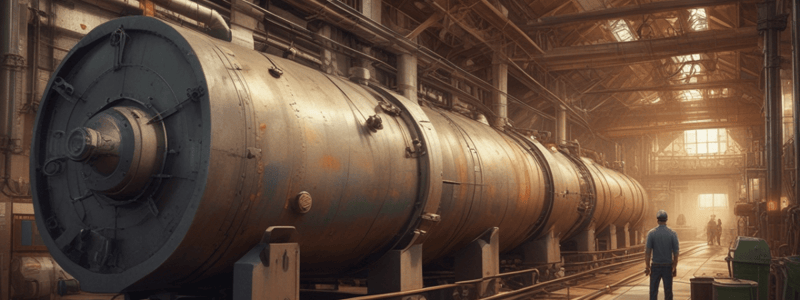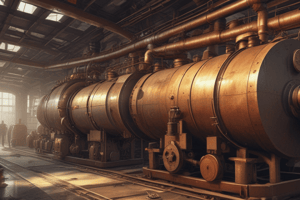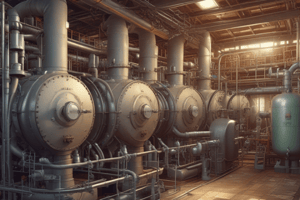Podcast
Questions and Answers
EASY What are the two main parts of an internal inspection?
EASY What are the two main parts of an internal inspection?
- Waterside and fireside (correct)
- Mechanical and chemical
- Visual and auditory
- Hydrostatic and chemical
Before starting the waterside inspection, what must be done to the boiler?
Before starting the waterside inspection, what must be done to the boiler?
- Cleaned and lubricated
- Filleted and polished
- Shut down, isolated, and locked out (correct)
- Turned on and inspected
What is examined during the waterside inspection?
What is examined during the waterside inspection?
- Boiler drums and superheaters only
- Boiler drums, drum internals, and waterwalls
- Only the economizer and superheaters
- All of the above and more (correct)
Why are pressure parts cleaned internally?
Why are pressure parts cleaned internally?
What is analyzed in a detailed inspection report?
What is analyzed in a detailed inspection report?
During the waterside inspection, what is the inspector looking for?
During the waterside inspection, what is the inspector looking for?
What must be removed to allow inspection for scale or other deposits?
What must be removed to allow inspection for scale or other deposits?
What may be done after the waterside inspection is completed?
What may be done after the waterside inspection is completed?
Why would an inspector request the removal of refractory or insulation during a fireside inspection?
Why would an inspector request the removal of refractory or insulation during a fireside inspection?
What is the purpose of a hydrostatic test on a boiler?
What is the purpose of a hydrostatic test on a boiler?
What should the temperature of the water be during a hydrostatic test?
What should the temperature of the water be during a hydrostatic test?
Why must all air be vented from the boiler during a hydrostatic test?
Why must all air be vented from the boiler during a hydrostatic test?
What is the purpose of pressurizing the boiler during a hydrostatic test?
What is the purpose of pressurizing the boiler during a hydrostatic test?
How long must the pressure be held during a hydrostatic test?
How long must the pressure be held during a hydrostatic test?
What must be done with the safety valve during a hydrostatic test?
What must be done with the safety valve during a hydrostatic test?
Why are the gauge glass connections closed during a hydrostatic test?
Why are the gauge glass connections closed during a hydrostatic test?
What should be done after the hydrostatic test is complete?
What should be done after the hydrostatic test is complete?
What is the purpose of the Power Engineer during a fireside inspection?
What is the purpose of the Power Engineer during a fireside inspection?
MEDIUM During a fireside inspection, what is the primary reason for removing sections of refractory or insulation?
MEDIUM During a fireside inspection, what is the primary reason for removing sections of refractory or insulation?
What is checked during a fireside inspection?
What is checked during a fireside inspection?
What is the primary purpose of a hydrostatic test on a boiler?
What is the primary purpose of a hydrostatic test on a boiler?
What should be closed during a hydrostatic test?
What should be closed during a hydrostatic test?
What is the recommended temperature range for the water during a hydrostatic test?
What is the recommended temperature range for the water during a hydrostatic test?
Why must all air be vented from the boiler during a hydrostatic test?
Why must all air be vented from the boiler during a hydrostatic test?
What is the purpose of pressurizing the boiler during a hydrostatic test?
What is the purpose of pressurizing the boiler during a hydrostatic test?
What should be done with the safety valve during a hydrostatic test?
What should be done with the safety valve during a hydrostatic test?
What should be done after the hydrostatic test is complete?
What should be done after the hydrostatic test is complete?
During a fireside inspection, what is the role of the Power Engineer?
During a fireside inspection, what is the role of the Power Engineer?
What is the primary purpose of removing deposits from pressure parts during a waterside inspection?
What is the primary purpose of removing deposits from pressure parts during a waterside inspection?
What is the significance of analyzing the deposit composition in a detailed inspection report?
What is the significance of analyzing the deposit composition in a detailed inspection report?
Why is it essential to check stays during a waterside inspection?
Why is it essential to check stays during a waterside inspection?
What is the purpose of opening pressure control lines during a waterside inspection?
What is the purpose of opening pressure control lines during a waterside inspection?
What is the significance of inspecting drum welds during a waterside inspection?
What is the significance of inspecting drum welds during a waterside inspection?
What should be done with pigtails during a waterside inspection?
What should be done with pigtails during a waterside inspection?
Why is it important to inspect manhole and handhole openings during a waterside inspection?
Why is it important to inspect manhole and handhole openings during a waterside inspection?
What is the purpose of inspecting drum connections during a waterside inspection?
What is the purpose of inspecting drum connections during a waterside inspection?
HARD What is the primary reason for cleaning pressure parts internally during a waterside inspection?
HARD What is the primary reason for cleaning pressure parts internally during a waterside inspection?
What is the significance of analyzing deposit composition in a detailed inspection report?
What is the significance of analyzing deposit composition in a detailed inspection report?
Why is it essential to inspect drum welds during a waterside inspection?
Why is it essential to inspect drum welds during a waterside inspection?
What is the purpose of removing plugs in the water column, feeder, and low water cut-off connection piping during a waterside inspection?
What is the purpose of removing plugs in the water column, feeder, and low water cut-off connection piping during a waterside inspection?
Why is it important to inspect stays during a waterside inspection?
Why is it important to inspect stays during a waterside inspection?
What is the purpose of opening pressure control lines during a waterside inspection?
What is the purpose of opening pressure control lines during a waterside inspection?
Why is it essential to inspect manhole and handhole openings during a waterside inspection?
Why is it essential to inspect manhole and handhole openings during a waterside inspection?
What is the purpose of inspecting drum connections during a waterside inspection?
What is the purpose of inspecting drum connections during a waterside inspection?
What is the primary purpose of inspecting the tubesheet ligaments during a fireside inspection?
What is the primary purpose of inspecting the tubesheet ligaments during a fireside inspection?
What is the recommended procedure for venting air from the boiler during a hydrostatic test?
What is the recommended procedure for venting air from the boiler during a hydrostatic test?
What is the primary reason for removing or blocking off certain controls during a hydrostatic test?
What is the primary reason for removing or blocking off certain controls during a hydrostatic test?
What is the purpose of filling the boiler with water between 20°C and 50°C during a hydrostatic test?
What is the purpose of filling the boiler with water between 20°C and 50°C during a hydrostatic test?
What is the primary responsibility of the Power Engineer during a fireside inspection?
What is the primary responsibility of the Power Engineer during a fireside inspection?
What is the significance of inspecting the ends of firetubes during a fireside inspection?
What is the significance of inspecting the ends of firetubes during a fireside inspection?
What is the primary purpose of holding the pressure at 1 ½ times the MAWP during a hydrostatic test?
What is the primary purpose of holding the pressure at 1 ½ times the MAWP during a hydrostatic test?
What is the recommended procedure for releasing the pressure after a hydrostatic test?
What is the recommended procedure for releasing the pressure after a hydrostatic test?
What is the primary purpose of inspecting the refractory and brickwork of the burners during a fireside inspection?
What is the primary purpose of inspecting the refractory and brickwork of the burners during a fireside inspection?
What is the significance of the ASME Boiler and Pressure Vessel Code, Section VII, during a hydrostatic test?
What is the significance of the ASME Boiler and Pressure Vessel Code, Section VII, during a hydrostatic test?
Flashcards are hidden until you start studying
Study Notes
Internal Inspection
- Consists of a waterside inspection and a fireside inspection
Waterside Inspection
- Examines boiler drums, drum internals, tube connections, waterwalls, superheaters, economizer, and fittings
- Pressure parts are examined for deposits and scale and may be cleaned internally using mechanical or chemical methods
- A detailed inspection report may be required, including measurement of deposit thickness and lab analysis
- Inspector looks for signs of corrosion, pitting, and cracking of metal surfaces
- Stays are checked for looseness and cracking at the fastened ends
- Particular attention is paid to manhole and handhole openings and drum connections
Fireside Inspection
- May require removal of refractory or insulation to facilitate inspection of tube or drum surfaces
- Fireside surfaces are examined for bulges and blisters, indicating overheating
- Ends of firetubes are checked for signs of leakage, and tubesheet ligaments for cracking
- Tubes adjacent to soot blowers are examined for signs of erosion due to direct steam impingement
- Refractory and brickwork of burners, baffles, and furnace walls are checked for deterioration
Hydrostatic Test
- Enables inspector to check tightness of pressurized parts of a boiler and find small leaks
- Detailed requirements for hydrostatic tests are described in ASME Boiler and Pressure Vessel Code, Section VII, and National Board Inspection Code
- Procedures for heating boilers and power boilers differ
Power Boiler Procedure for Hydrostatic Test
- Close manholes and handholes, ensuring no debris or tools are left in drums
- Close all valves, except vent valve and feedwater supply valve, and gauge glass connections
- Remove or block off any control that cannot withstand hydrostatic test pressure
- Fill boiler with water between 20°C and 50°C, venting all air from highest points
- Pressurize boiler slowly to 1 ½ times MAWP, holding pressure for inspection
- Visually inspect all accessible pressurized parts for signs of leakage, and observe pressure gauge for drops in pressure
- After test, crack open a drain and allow pressure to slowly bleed off, closing all drains unless intending to drain boiler further
Internal Inspection
- Consists of a waterside inspection and a fireside inspection
Waterside Inspection
- Examines boiler drums, drum internals, tube connections, waterwalls, superheaters, economizer, and fittings
- Pressure parts are examined for deposits and scale and may be cleaned internally using mechanical or chemical methods
- A detailed inspection report may be required, including measurement of deposit thickness and lab analysis
- Inspector looks for signs of corrosion, pitting, and cracking of metal surfaces
- Stays are checked for looseness and cracking at the fastened ends
- Particular attention is paid to manhole and handhole openings and drum connections
Fireside Inspection
- May require removal of refractory or insulation to facilitate inspection of tube or drum surfaces
- Fireside surfaces are examined for bulges and blisters, indicating overheating
- Ends of firetubes are checked for signs of leakage, and tubesheet ligaments for cracking
- Tubes adjacent to soot blowers are examined for signs of erosion due to direct steam impingement
- Refractory and brickwork of burners, baffles, and furnace walls are checked for deterioration
Hydrostatic Test
- Enables inspector to check tightness of pressurized parts of a boiler and find small leaks
- Detailed requirements for hydrostatic tests are described in ASME Boiler and Pressure Vessel Code, Section VII, and National Board Inspection Code
- Procedures for heating boilers and power boilers differ
Power Boiler Procedure for Hydrostatic Test
- Close manholes and handholes, ensuring no debris or tools are left in drums
- Close all valves, except vent valve and feedwater supply valve, and gauge glass connections
- Remove or block off any control that cannot withstand hydrostatic test pressure
- Fill boiler with water between 20°C and 50°C, venting all air from highest points
- Pressurize boiler slowly to 1 ½ times MAWP, holding pressure for inspection
- Visually inspect all accessible pressurized parts for signs of leakage, and observe pressure gauge for drops in pressure
- After test, crack open a drain and allow pressure to slowly bleed off, closing all drains unless intending to drain boiler further
Internal Inspection
- Consists of a waterside inspection and a fireside inspection
Waterside Inspection
- Examines boiler drums, drum internals, tube connections, waterwalls, superheaters, economizer, and fittings
- Pressure parts are examined for deposits and scale and may be cleaned internally using mechanical or chemical methods
- A detailed inspection report may be required, including measurement of deposit thickness and lab analysis
- Inspector looks for signs of corrosion, pitting, and cracking of metal surfaces
- Stays are checked for looseness and cracking at the fastened ends
- Particular attention is paid to manhole and handhole openings and drum connections
Fireside Inspection
- May require removal of refractory or insulation to facilitate inspection of tube or drum surfaces
- Fireside surfaces are examined for bulges and blisters, indicating overheating
- Ends of firetubes are checked for signs of leakage, and tubesheet ligaments for cracking
- Tubes adjacent to soot blowers are examined for signs of erosion due to direct steam impingement
- Refractory and brickwork of burners, baffles, and furnace walls are checked for deterioration
Hydrostatic Test
- Enables inspector to check tightness of pressurized parts of a boiler and find small leaks
- Detailed requirements for hydrostatic tests are described in ASME Boiler and Pressure Vessel Code, Section VII, and National Board Inspection Code
- Procedures for heating boilers and power boilers differ
Power Boiler Procedure for Hydrostatic Test
- Close manholes and handholes, ensuring no debris or tools are left in drums
- Close all valves, except vent valve and feedwater supply valve, and gauge glass connections
- Remove or block off any control that cannot withstand hydrostatic test pressure
- Fill boiler with water between 20°C and 50°C, venting all air from highest points
- Pressurize boiler slowly to 1 ½ times MAWP, holding pressure for inspection
- Visually inspect all accessible pressurized parts for signs of leakage, and observe pressure gauge for drops in pressure
- After test, crack open a drain and allow pressure to slowly bleed off, closing all drains unless intending to drain boiler further
Studying That Suits You
Use AI to generate personalized quizzes and flashcards to suit your learning preferences.




